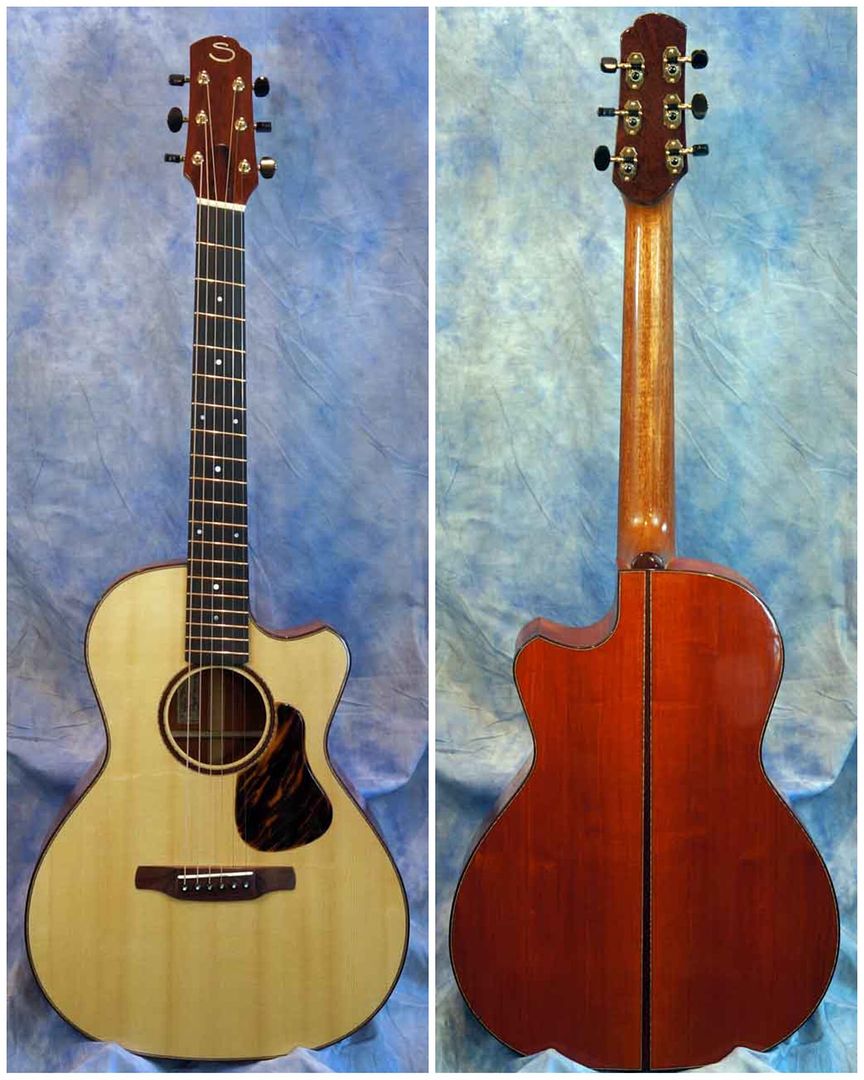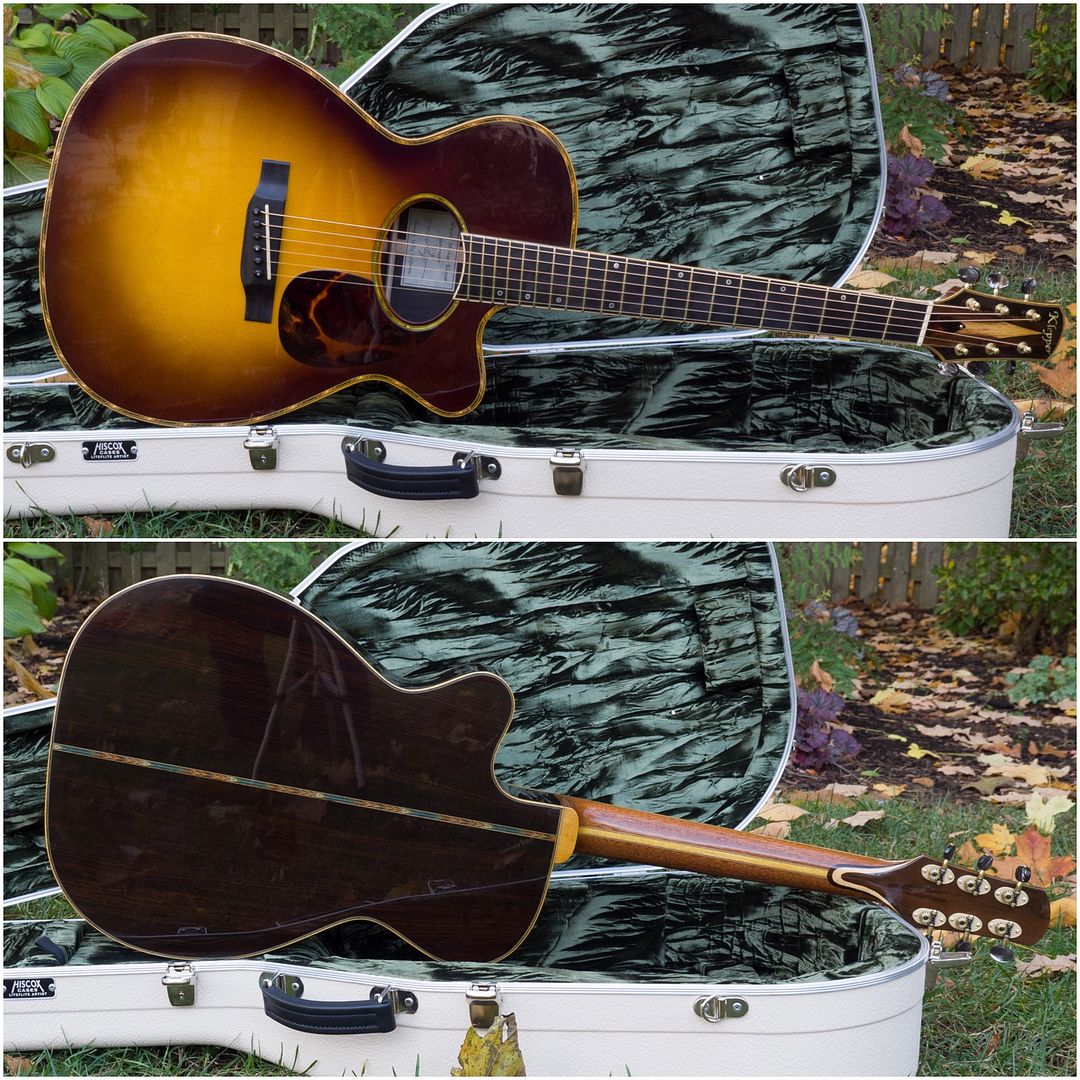-
My eyes hurt... Alex Bishop Guitars
-
01-04-2017 05:22 PM
-
Man!
-
That's some major scale difference ... 680-620mm = 26.77" - 24.41"
I like the stagger on the tuning machines.
I also wonder if the treble end of the moustache bridge would get in the way!
-
Looks like the characteristic bend in the soundboard is also at an angle..
-
It's as if Picasso designed a guitar.
-
This is what I don't understand about fanned frets. Every example I have seen has the frets slanted in the direction opposite of what would work better for my left hand. I suppose the idea is to get longer bass strings. I have enough trouble getting my wrist in proper position for a first fret bb minor barre chord.

-
You should try one out, it's actually ergonomically very friendly.
 Originally Posted by citizenk74
Originally Posted by citizenk74
-
I have a fan-fretted guitar. It is ergonomically OK, but a bar chord on the first fret is almost impossible, a little better for the next fret or two.
 Originally Posted by ronjazz
Originally Posted by ronjazz
Last edited by Slide; 01-04-2017 at 09:39 PM.
-
Correct! I have a Novax guitar and bass, and I helped Ralph out a couple years at NAMM; I watched 100 people pick up the guitars, play around for a bit, and say two things: "Nice guitar! Easy to play!"
 Originally Posted by ronjazz
Originally Posted by ronjazz
-
No, that's this one
 Originally Posted by entresz
Originally Posted by entresz

Manzer Guitars - Pikasso

Sent from my iPhone using Tapatalk
-
Now that fanned gypsy is a work of art! Love it.
Here's the video that is mention on the luthier's webpage...
Last edited by Steve Z; 01-05-2017 at 08:43 AM.
-
It sounds somewhere between a gypsy-jazz guitar and a regular flat top acoustic.
-
Check out the luthier's FaceBook page for pics of other guitars... stunning!
https://www.facebook.com/alexbishopguitars
-
01-05-2017, 09:14 AM #14joaopaz Guest
Wonderful work of art!
Love the inlays around the soundhole, the bridge and the tailpiece following it.
-
Fan frets have been around for quite a while but has far as gypsy guitars go, Frank Beardsell has been making similar guitars for a number os years. Even fan fret archtops.
New Beardsell 3GMS/25/27 - Acoustic Guitar at Dream Guitars
Instruments for Sale — Beardsell Guitar WorkshopLast edited by rob taft; 01-05-2017 at 06:00 PM. Reason: I hate typing on a tablet!!
-
Oh, fanned frets date back to at least the early 17th century. Here's an Orpharion from 1617:
-
Orpharions were steel-strung, and tuned and played as a lute.
-
I have two multi-scale guitars (I believe fan fret is a trademarked name by Ralph) but the scale offsets is far more subtle. One has a 1/4" offset (25.0" to 25.25") with the low E being the longer scale and the other with a 1/2" offset (24.9" to 25.4") with the low E being the longer scale. The most vertical fret on the 1/4" offset is the highest fret (19th)with the frets getting more offset to the nut and on the 1/2" offset, it is the 8th fret is the vertical fret with the offset increasing towards both the nut and the saddle. I find this subtle offset easy to adjust to playing wise (completely transparent at this point). The shorter scale in the treble strings provides a sweeter timbre and the longer scale in the bass strings provides a bit more power.
1/4"

1/2"

Last edited by iim7V7IM7; 01-06-2017 at 09:33 PM.
-
I've been playing a fanned fret five string electric bass for over a decade. It goes from 37 inches on the low B to 34 on the high G
The advantage of fanned frets is mostly that string tension is more even. This is really obvious in a five string bass: most of the time on a five string the low B string will be much lower tension than the other strings and will need to be played differently. Its also true of the low E. although less so. On a fanned fret bass, all the strings are at closer to the same tension, so they all play the same. I've found that over time, the thing I've come to look for most in an instrument is relative even-ness--no hot spots, no dead spots, no dramatic shifts in timbre across up and down and across the fret board. it's easier to play an instrument when the response to your touch is consistent, and you don't have to play "around" certain spots on the neck because they sound noticeably different.
So in my experience fanned frets make the bass more consistent-feeling. But I'd also say that ergonomically, they have advantages and disadvantages. At the extremes--the low and the high end--they can get noticeably less comfortable than a conventional board. In the middle range, they are MORE comfortable.
I've never tried a fanned fret guitar, and I've never tried to build one, partly because I've never felt the need very strongly on guitar.




 Reply With Quote
Reply With Quote







(N-ishGD) - Schorr The Owl The Owl 7-string
Today, 08:10 AM in Guitar, Amps & Gizmos